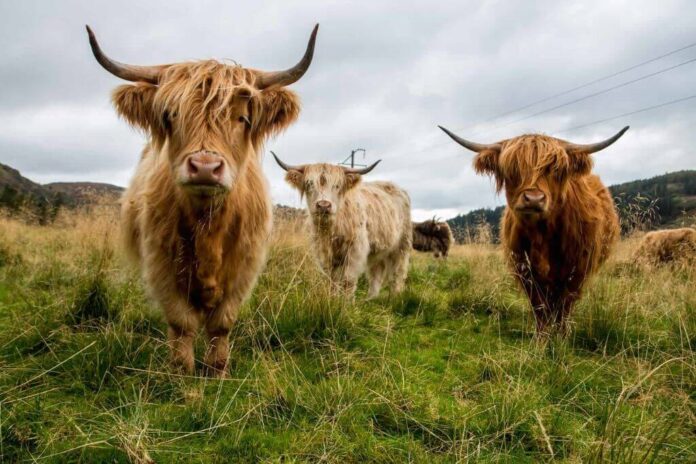Amid the rugged, romantic landscape of the Isle of Skye, a crop of forward-thinking architects, chefs, and cultural custodians are transforming their remote island.
I have long been fascinated by maps of islands. An island will forever be bounded by its shores; because of these inherent limits, it offers the possibility of knowing a place in its entirety. And yet I find that islands, despite their finitude, often prove to be unknowable. The closer you look, the more is revealed.
The Isle of Skye is one of these unknowable places. Unfurling from the west coast of Scotland like the wing of a prehistoric beast, its northerly tip reaches toward the rocky parenthesis of the Outer Hebrides and the great Atlantic beyond. The incredible variety of its landscapes—saw-toothed mountains, heathered moorlands, pristine lochs, and white-sand beaches, all contained within a 50-mile-long island—leave the visitor with the impression that the whole of Scotland, or perhaps even the world, has been replicated here in miniature, a fractal vision of the whole.
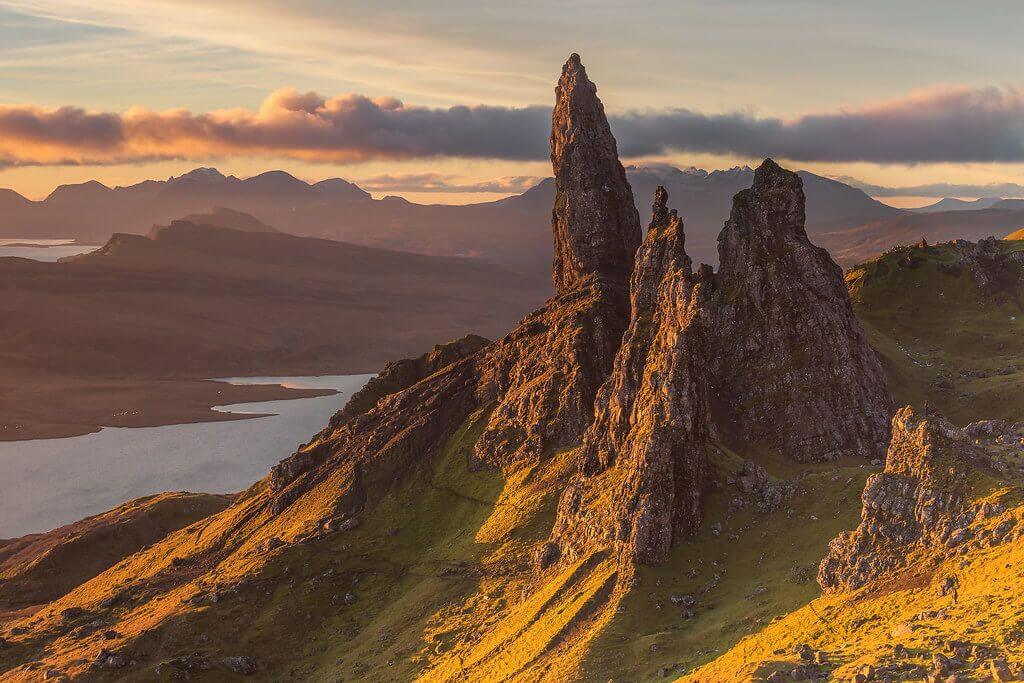
After making several trips to Skye last summer, it struck me that the island’s synecdochic qualities extend far beyond the geographical. It is a place where the ancient now collides with the contemporary, a place where after a long day hiking across wild, Precambrian terrain, you can stop and sample seared wild pigeon in a beet crème fraîche at a Michelin-starred restaurant. And as such, the Isle of Skye has become a microcosm of a broader cultural shift taking place across Scotland. © Simon Roberts
I’m a relatively recent witness to this change. In August 2014, my family and I uprooted ourselves from upstate New York and moved to the Scottish city of St. Andrews, where my wife and I had taken jobs at the university. We had chosen an interesting time to move, as the Scots were preparing to vote on a referendum that had the potential to declare their land a sovereign country. Rarely does one get to witness a people take the measure of themselves in such a profound way; the vote was all anyone could talk about. And though in the end the referendum was defeated, the pro-independence Scottish National Party and the “Yes” campaign managed to inspire an infectious sense of national agency that flowed into 2015’s parliamentary elections, in which the SNP won an astonishing 56 out of Scotland’s 59 seats, after having captured only six just five years earlier.
The election was perhaps the strongest evidence of a shift that has been under way for decades. Scotland was for centuries viewed as a remote, mostly rural backwater of Britain—a stereotype that has slowly been eroded, first by the boom in its natural-gas and petroleum industries in the 1980s and 90s, and more recently through exports of its wildly popular luxury goods, notably whisky and salmon. Even as the U.K. considers a split from the European Union, Scotland, its livelihood entangled in multiple markets from North America to Australia, has pivoted in the other direction, toward a wider, more interconnected world.
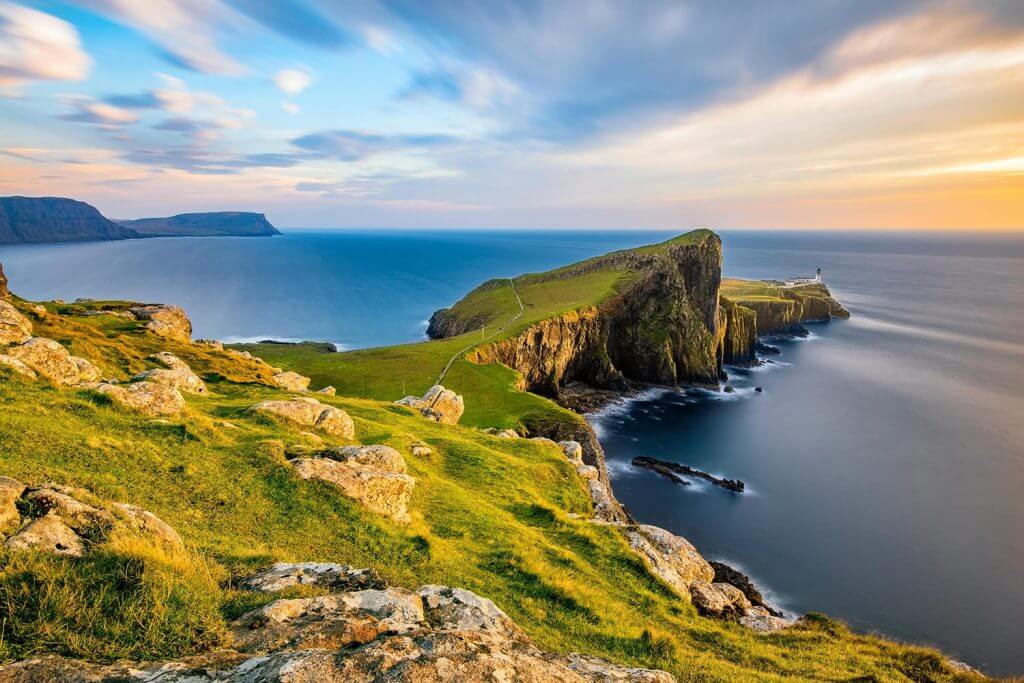
Like the rest of Scotland, the Isle of Skye is recasting its native traditions within this new global context. In the international marketplace, the concept of “local” is a seductive commodity. Not surprisingly, therefore, the island’s name has become a powerful brand. Slap the word Skye on anything from soap to candles, and it instantly assumes a tangle of desirable associations: remote yet of-the-moment, rural yet sophisticated, rugged yet luxurious. © Simon Roberts
This was not always the case. Once upon a time, the island’s name conjured stories of poverty and bloody clan warfare. During the Highland Clearances of the 18th and 19th centuries, a large portion of the population was evicted from their land and forced into a form of tenant farming known as crofting; many more Highlanders emigrated to Australia and North America. In 1841, just before the worst of the clearances, more than 23,000 people lived on Skye; by 1931, this figure had shrunk to fewer than 11,000. Throughout the 20th century, the island, like much of rural Scotland, struggled to retain its people and its traditions. Only in the past 20 years or so has it evolved into a showcase for Gaelic culture, gastronomy, and design.
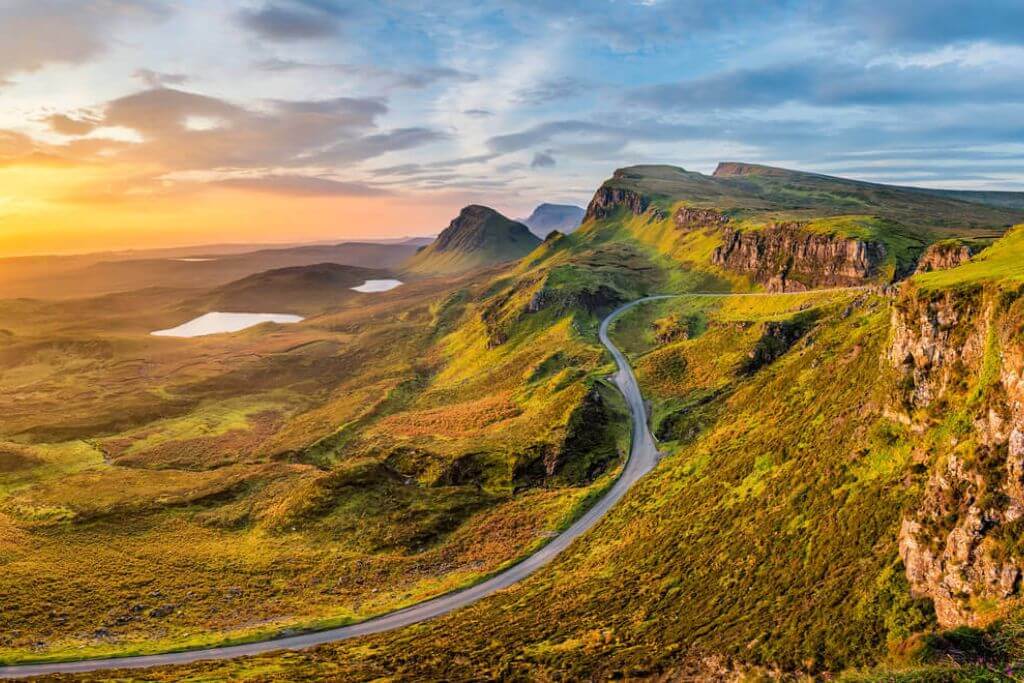
On my most recent visit to Skye, I traveled by car from St. Andrews, weaving east to west through a jigsaw of mountains, lochs, and glens. In Scotland there is rarely a direct route from one place to another, but the landscape is so effortlessly gorgeous that one tends to forgive the detours. It is not uncommon to see a driver pulled over to the side of the road, door flung open, jacket flapping in the wind, engaged in wordless communion with the land.
For centuries Skye was accessible only by ferry, but these days you can drive directly onto the island, via the Skye Bridge. When this concrete-and-steel structure was completed in 1995, it opened up a pipeline for tourism. In its first year alone, the bridge brought 612,000 vehicles onto the island. The bridge rises across the narrowest point of Loch Alsh, its arch dwarfing the now redundant lighthouse on the island of Eilean Bàn, where the writer Gavin Maxwell, author of a 1960 memoir called
Ring of Bright Water
, once lived in the keeper’s cottage. Maxwell would no doubt have disapproved of using his beloved Eilean Bàn to support a causeway to Skye, but such is the way of change—layered, inevitable, always taking the path of least resistance. © Simon Roberts
I stayed in a rental cottage just south of the Trotternish peninsula in Skeabost. A timber-sided house with an interior of white, clean lines and a huge wall of glass that sucked in the views, it was part of a series of prefab homes known as R. Houses. These are the invention of an architectural firm called Rural Designs based in Portree, Skye’s largest town, with a population of about 2,300. Rural Designs, along with Dualchas Architects, is part of an architectural movement that draws on traditional forms like thatched, stone-walled cottages called black houses, while using local materials to create affordable, efficient homes.
“Many people in the
older generations
were ashamed of the old black houses,” said Neil Stephen, who founded Dualchas with his brother Alasdair. “They symbolized the poverty that this island experienced after the Clearances.” Neil and his team decided to take practical instruction from these designs—their low-pitched lines that protect against wind, their placement on a rise, their east-west orientation toward the sun. “We wanted to celebrate the history of the island through form,” he said.
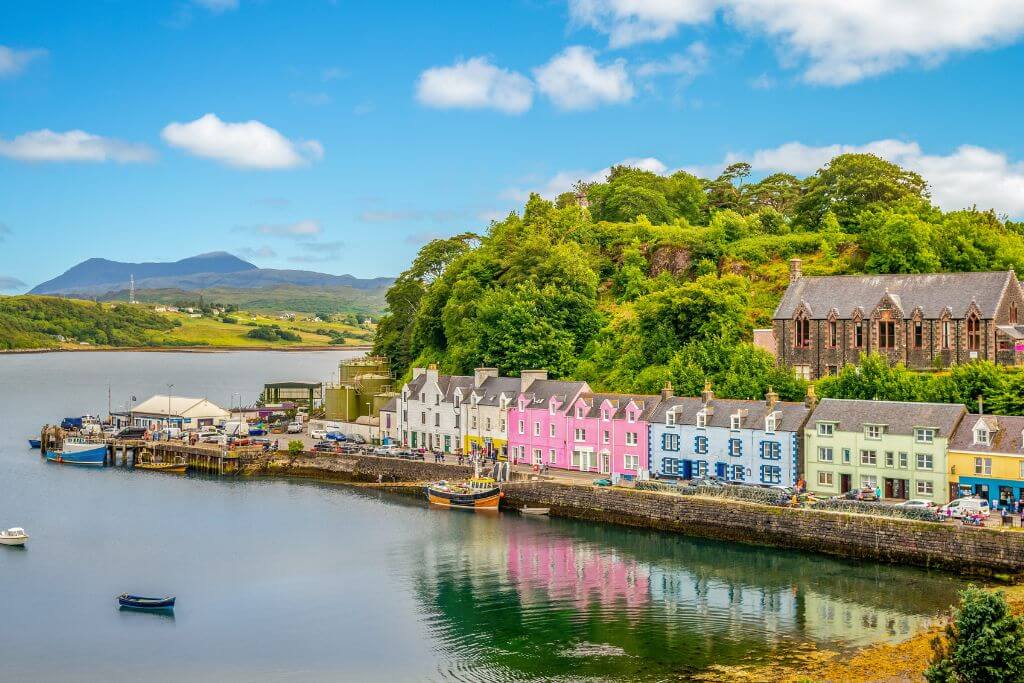
Dualchas’s new houses employ materials like larch wood, which is naturally resistant to the wet weather of the isles. “We don’t want our houses to stand out from the landscape—we want them to blend into it,” Neil said. I asked him what had changed on the island. “Twenty years ago there were no new houses of note anywhere in the Hebrides, but now there are many that have won design awards. People have a vision of what they want.”
This evolution is perhaps most evident in the development of local cuisine. Scotland has historically enjoyed a less-than-favorable reputation for its food (think deep-fried Mars bars). Samuel Johnson perhaps expressed it most colorfully when he wrote in his famous dictionary entry for oats: “A grain which in England is given to horses but in Scotland supports the people.” © Simon Roberts
But this reputation is not entirely fair. For while it is true that the country’s Calvinistic bent often meant food preparation was considered an indulgence rather than a necessity, Scotland has always produced some of the finest ingredients in the world, whether they have fins, legs, or leaves. Almost 75 percent of the country is made up of farmland and common grazing areas, and its seas are bursting with life. Now the age of deep-frying has finally given way and the chefs have arrived, in great numbers—2015 was officially the Year of Food & Drink in Scotland. In 2014 the Three Chimneys restaurant became the second on Skye to be awarded a Michelin star, joining Kinloch Lodge, which earned its star in 2010. Though the Three Chimneys lost its star after hiring a new chef last summer, it’s still a remarkable achievement for such a remote place—especially considering that Glasgow and Manchester, the third- and seventh-largest cities in the U.K., respectively, have zero Michelin stars between them.
To get to the Three Chimneys, you must turn off the main road just south of Dunvegan onto a long, single-track lane. The narrowness of these tracks, which form a weblike network across the island, cultivates a kind of camaraderie among drivers, as custom dictates that one vehicle must pull over and make way while the other driver acknowledges the courtesy with a wave. Thus travel across Skye becomes a ballet of graciousness. When I finally arrived at the Three Chimneys, I had waved at more strangers in a day than I had in the previous year.
All gallantry immediately evaporated when I pulled up in front of the restaurant, where a jet-black helicopter descended loudly from the pall and deposited a group of diners on the beach in front of the restaurant. So it goes when you join the Michelin club. And I’m sure the helicopter passengers were not disappointed, for the food was wonderful. The Skye Seafood Lunch prix fixe started with a modern take on Cullen skink, the traditional Scottish haddock soup, featuring black pudding—marag dubh in Gaelic—and a dash of local Talisker whisky. The main seafood platter was, quite literally, a deep dive into local waters, featuring resplendent Loch Dunvegan prawns, Sconser scallops, Loch Harport oysters, and potted Colbost crab.
Shirley Spear opened the Three Chimneys with her husband, Eddie, in 1985, and was for many years its head chef (she now oversees the restaurant and on-site hotel). She’s witnessed firsthand the change in attitudes toward food. “When I started out, people used to throw out shellfish,” she said. “Now Scotland’s seafood is world-famous.”
Spear has also flipped Dr. Johnson’s ridicule of oats on its head. For her, “the Scottish oat is to be praised,” and the Three Chimneys features the ingredient in several of its dishes, including its hot marmalade pudding soufflé with Drambuie syrup and mealie ice cream inflected with toasted oatmeal. Even the house-made oatcakes—served with an array of Scottish cheeses—are a revelation; they are both rich and delicate, melting in your mouth and lingering in your imagination. I, for one, will never look at oats in quite the same way. © Simon Roberts
The Michelin-starred Kinloch Lodge has a similarly well-established reputation. “It is all about the ingredients,” said Lady Claire MacDonald, whose husband is the High Chief of Skye’s famous Clan Donald. “And I truly believe we have the best ingredients in Scotland.” She’s been managing Kinloch Lodge for 43 years now, and is considered a key figure in the resurgence of Scottish cuisine.
Marcello Tully, the head chef at Kinloch Lodge, said he laughs when he sees a London restaurant claim something is local. “Where did it come from? Piccadilly Circus? Here, local is a given.” He pointed to the loch. “The fish comes from there.” Born in Brazil but trained in French cooking, Tully was hired by Lady MacDonald in 2007 and rewarded her with a Michelin star two years later. His specialty is pairing Scottish ingredients with the Brazilian techniques of his upbringing, often blending sweet and savory together in unexpected ways—such as in an outrageously flavorful cherry wrapped in delicate black pudding.
There’s a similar buzz in Portree, where everyone was talking about a young local chef called Calum Munro. Munro worked for Tully at Kinloch Lodge and then ran a restaurant in Paris before returning home to Skye. In the summer of 2013, he opened a pop-up restaurant called Scorrybreac in his parents’ dining room, to wild acclaim. (“My father was doing the dishes!” he told me.) This past summer he moved into a restaurant space overlooking the harbor—much to his parents’ relief, no doubt. Still only a two-man operation, the kitchen turns out a Scottish-French ensemble menu using the ingredients available locally that day. House specialties include coffee-seared venison loin with chanterelles and parsnip purée. It was one of the best meals I’ve ever eaten. Good luck getting a seat, however— the tiny restaurant is usually booked weeks in advance.
Calum’s father is a local legend named Donnie Munro, formerly the frontman of a well-known Scottish rock band called Runrig. Donnie Munro is now the director of arts and development at Sabhal Mòr Ostaig, the Gaelic college on Skye, which was founded in 1973 and has since played a critical role in the preservation of Gaelic language and culture. Sabhal Mòr Ostaig’s campus is just down the road from Kinloch Lodge on the peninsula of Sleat, a lush, undulating area often referred to as the Garden of Skye. The college has become a nexus for cultural programming in the Gaelic-speaking community, hosting an artist-in-residency program, providing production facilities for Gaelic television and radio, and offering a platform for the community to celebrate its Gaelic roots.
During the second half of the 20th century, the number of Gaelic speakers in Scotland plunged by almost 40 percent. Over the past 15 years, however, this decline has been all but halted. After a long history of government suppression, the Gaelic Language Act of 2005 gave official recognition to the language, and it’s now widely taught in schools and spoken in the media.
With Gaelic now viewed as a cultural commodity rather than a provincial peculiarity, the language is adapting to the times. On Skye, words and phrases that were rooted in pastoral or religious meaning are now being used in distinctly modern situations. Take, for example, the word
leasachadh
, which originally meant “manure made from seaweed.” Its fertile associations have been updated, and it now means publicly subsidized economic or social development.
Lìonra
once referred to “a tool for transferring yarn from a spindle” but now means “computer network.”
Sabhal Mòr Ostaig is at the center of this balancing act between past and future, strengthening Skye’s Gaelic roots while acknowledging that the best way to preserve tradition is to repurpose it for the modern world. One of the school’s most exciting new initiatives is creating the first planned village on Skye in almost 100 years: Kilbeg, which will have 21st-century facilities and Gaelic as its working language.
Leasachadh
, indeed. © Simon Roberts
On my final day on Skye I drove down the single track to the village of Elgol, which overlooks the Isle of Soay and the Black Cuillin hills rising high above Loch Scavaig. At one point I found my car surrounded by a herd of Highland cattle, and could drive neither forward nor back. The animals looked like extras from the Jim Henson workshop, covered in a coat of shaggy ocher fur. Despite their gentle, almost aloof demeanor, they each also sported a pair of two-foot horns. So it was with great care that I rolled down my window to take a few photos with my phone.
I tried to send a picture back to my wife in St. Andrews, with the accompanying caption “Welcome to Scotland, our new home.” Not for the first time on this trip, however, my phone had no reception. It occurred to me that perhaps, in the contemporary world, the only places that can truly be defined as unknowable are those beyond the reach of a wireless signal.
The bull nearest me seemed to sense my helplessness. He turned his mighty head in my direction—nearly taking out my side mirror with a horn in the process—and nodded. Well, so be it. The future could wait; I would send my message later. I settled back and watched the herd clear in its own time, tapping my fingers to the old Gaelic tune on the radio.
